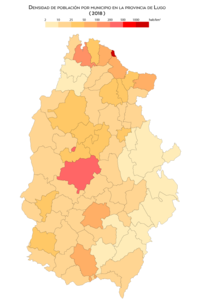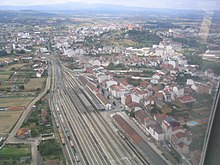Lugo Province
Lugo is a Spanish province, one of the four that make up the autonomous community of Galicia. It limits to the north with the Cantabrian Sea, to the west with the province of La Coruña, to the southwest with that of Pontevedra, to the south with the province of Orense and to the east with the Principality of Asturias and the province of León.
Although it is the largest of the four Galician provinces, it is the third in number of inhabitants (326,013 in 2021).
Its capital is Lugo and the main towns, apart from the capital, are Monforte de Lemos, Vivero, Villalba, Sarria and Foz.
The main rivers are the Sil and the Miño, which also runs through the province of Ourense and forms the border between the province of Pontevedra and Portugal, flowing into the Atlantic. On the Cantabrian coast it has many small rivers.
Demographics
The population of the province of Lugo has experienced a strong and continuous decline since the 40s of the 20th century, mainly motivated by low fertility, but also by emigration to the other coastal provinces of Galicia, to other provinces of Spain and abroad, mainly to Latin American countries such as Argentina or Uruguay.
| Graphic of demographic evolution of the province of Lugo between 1842 and 2018 |
 |
Source: Spanish National Statistical Institute - Graphical development by Wikipedia. |
Geography
Provincial boundary
Rías
The estuaries of the province of Lugo are part of the Rías Altas. From west to east they are:
- Ría del Barquero, mouth of the river Sor, border of the provinces of Lugo and La Coruña.
- Ría de Vivero, mouth of the Landro River, north of Vivero.
- Ría de Foz, mouth of the river Masma, east of Foz.
- Ría de Ribadeo, mouth of the river Eo, boundary between Galicia and Asturias.
Rivers
- Rio MiñoIt is born in the Meira mountain range and flows into the Atlantic Ocean on the Spanish-Portuguese border.
- Rio Eume, born in Abadín and flows into the Ría de Pontedeume in the province of La Coruña.
- Rio Sil, born in the region of Babia (Leon) and flows into the Miño River.
- River Landro, born in the Gistral mountain range and flows into the ria of Vivero.
- Rio OuroIt is born in the Gistral mountain range and flows into the Cantabrian Sea.
- Río Masma, born in the Tojiza mountain range and flows into the Foz river.
- Rio Eo, born in the region of Fonsagrada and flows into the river of Ribadeo.
- Rio Ladra, born in Vilalba and flows into the Miño River.
- Río NarlaIt is born in the mountains of the Corno de Boi and flows into the Miño River.
- Rio Anllo, born in the Gistral mountain range and flows into the Miño River.
- Rio Lea, born in the mountain range of the Monciro and flows into the river Miño.
- Rio NeiraIt is born in the Portelo mountain range and flows into the Miño River.
- Río Navia, born in Los Ancares and flows into Navia (Asturias).
- Rio Cabe, born in Incio and flows into the Sil River.
- Rio Lor, born in the Caurel mountain range and flows into the Sil River.
- Rio Ulla, born in the parish of Olveda, Antas de Ulla and flows into the Atlantic Ocean in the Ría de Arosa.
Cables
The best known are:
- Punta Socastroin the municipality of Vicedo.
- Punta Roncadoirain the municipality of Jove.
- Cape of Morásin the municipality of Jove.
- Cabo de San CibraoIn the municipality of Cervo.
- Corporal Burelain the municipality of Burela.
Municipalities
The following table shows all the municipalities in the province of Lugo as well as their population as of January 1, 2021:
The municipalities of Castro de Rey and Otero de Rey are located in the metropolitan area of the city of Lugo, thus adding (and together with the municipalities of Rábade and Corgo) an area of 113,117 inhabitants as of 1/1/ 2018.
The province of Lugo is the 31st in Spain in which there is a higher percentage of inhabitants concentrated in its capital (29.59%, compared to 31.96% for the whole of Spain).
Communications
Road network
- A-6: Arteijo - La Coruña - Lugo - Ponferrada - Benavente - Medina del Campo - Madrid.
- N-634 (future A-8): Santiago de Compostela - Villalba - Ribadeo - Gijón - Santander - Bilbao - San Sebastián
- N-120 (A-76): Logroño - Burgos - León - Monforte de Lemos - Orense - Vigo
- CG-2.1: Lalin (AP-53) - Chantada - Monforte de Lemos
- CG-2.2: Lugo - Sarria - Monforte de Lemos
- CG-2.3: Vicedo - Vivero - Burela - San Ciprián
- N-547 (A-54): Santiago de Compostela - Mellid - Palas de Rey - Guntín (N-540)
- N-642 (A-82): Ferrol - Ortigueira - Vivero - Burela - Foz
- N-540 (A-56): Lugo - Guntín (N-547) - Chantada - Orense
- N-640: Vegadeo-Ribadeo (N-634) - Lugo - Lalín - Villagarcía de Arosa
Rail transport
- The Coruña-Palencia (Renfe) passing through Lugo, Sarria and Monforte de Lemos.
- Vigo-Orense-Monforte de Lemos (Renfe)
- Ferrol-Oviedo (FEVE) passing through Vivero, Burela, Foz and Ribadeo.
Air transportation
- Rozas airfield (Lugo)
- Airfield of Villaframil (Ribadeo)
- Northern Costa (Vivero)
Culture
Languages
The vast majority of its inhabitants speak Galician as their habitual and majority language. Some people, especially the older ones, are monolingual Galician. It is only possible to find mixed Galician and Spanish speaking nuclei in some of the nuclei with more than 10,000 inhabitants, which are generally few. Even in the capital, the vitality of the Galician language in conversations is very strong.
Several variants of Galician are spoken in the province of Lugo. However, they have the characteristic of being the closest isoglosses to Leonese and therefore also to the Castilian languages, which is why they present some phonetic and grammatical signs that are erroneously considered to be influences from Spanish or Leonese. However, the Galician of Lugo, especially in non-coastal areas, is probably one of the most genuine[citation required] in all of Galicia, due to the almost zero influence[citation required] history of Spanish in the rural population.
Contenido relacionado
Miami
Occidental Sahara
Tolosa (Guipuzcoa)





